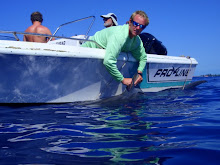 One would not imagine that a rubbermaid container, or as we call them "transport boxes", could be used as a refuge from the cold and the rain. However, these containers were our saving grace during the much awaited three-day Mini-Pit. The weather in early March delayed the project to a point where it could not be delayed any longer. A weather window (looked marginal at best) gave us an opportunity to go out and try to catch every shark in the North Sound. This allows us to get a general idea of how the shark population is doing before new pups are dropped off by their mothers in April and May. Lemon Shark mothers drop a litter of pups every other year and return to the same place they were born.
One would not imagine that a rubbermaid container, or as we call them "transport boxes", could be used as a refuge from the cold and the rain. However, these containers were our saving grace during the much awaited three-day Mini-Pit. The weather in early March delayed the project to a point where it could not be delayed any longer. A weather window (looked marginal at best) gave us an opportunity to go out and try to catch every shark in the North Sound. This allows us to get a general idea of how the shark population is doing before new pups are dropped off by their mothers in April and May. Lemon Shark mothers drop a litter of pups every other year and return to the same place they were born. Three teams set gillnets at different locations and a "tagging boat" was stationed at a large, central pen in the North Sound. Each night the nets were set for twelve hours and the nets were constantly watched with only 15 minutes between each check. The first night we caught 19 sharks and had ideal weather for gillnetting with warm weather, low wind, and high water visibility. The second night was cold and windy and the final night made me feel as if I was part of the "Deadliest Catch". As expected, our catches decreased with five sharks and three sharks on nights two and three, respectively.
Three teams set gillnets at different locations and a "tagging boat" was stationed at a large, central pen in the North Sound. Each night the nets were set for twelve hours and the nets were constantly watched with only 15 minutes between each check. The first night we caught 19 sharks and had ideal weather for gillnetting with warm weather, low wind, and high water visibility. The second night was cold and windy and the final night made me feel as if I was part of the "Deadliest Catch". As expected, our catches decreased with five sharks and three sharks on nights two and three, respectively. In order to get out of the cold we used what we had on the boat to create protection from the wind. We started off building a wall using dry boxers (coolers) and transport boxes (rubbermaid containers), but this arrangement had to be broken down and rebuilt before and after every check. After dinner was delivered at about 1AM on the second night we eventually forfeited the idea of creating a wall and fended for ourselves by using the rubbermaid containers as "turtle shells". As low tide approached, we were unable to drive he boat to check the net and we had to walk-check the net. As a boat we tried to stay as dry as possible and decided to do two checks per person and then have a break. With three people on the boat, this allowed about a 2-hour break in between your checks and provided a little time to get a nap.
After my last check at 0430 in the morning I passed out under my turtle shell to awake in a daze thinking everyone on my boat had abandoned me.
 When I woke up on the bow of the boat, I was delirious did not see anyone on my boat and thought that a mangrove in the distance was my two other crew members kneeling down to take a shark out of the net. Trying to gather my senses, I noticed a slight movement from the bench seat and was amazed that the lab manager, Emily, had squeezed in the bench seat and used the lid as a block from the wind. I then noticed Steve who had fit himself into an "egg " formed by two rubbermaid containers. Thankfully the wind died down as the second day came to and end as I watched a fantastic sunrise come over the mangroves. The old adage "red sky in the morning, sailor's warning" came true on the final night and made for an unpleasant experience.
When I woke up on the bow of the boat, I was delirious did not see anyone on my boat and thought that a mangrove in the distance was my two other crew members kneeling down to take a shark out of the net. Trying to gather my senses, I noticed a slight movement from the bench seat and was amazed that the lab manager, Emily, had squeezed in the bench seat and used the lid as a block from the wind. I then noticed Steve who had fit himself into an "egg " formed by two rubbermaid containers. Thankfully the wind died down as the second day came to and end as I watched a fantastic sunrise come over the mangroves. The old adage "red sky in the morning, sailor's warning" came true on the final night and made for an unpleasant experience.














